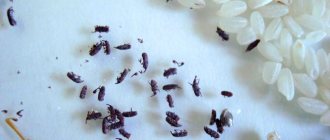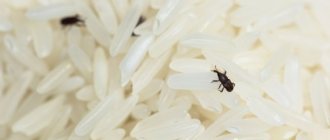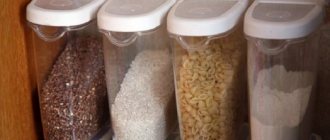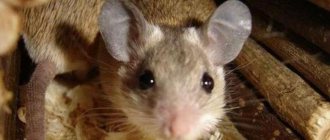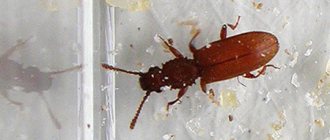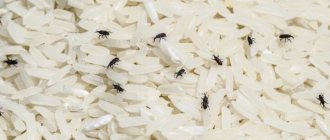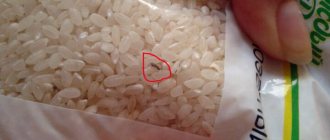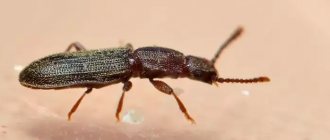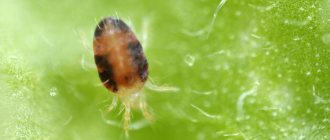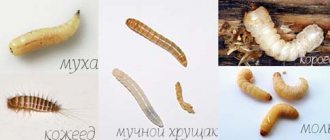Small nasty bugs in flour and cereals can be a real disaster. And such a misfortune occurs not only among slobs and lazy people; not a single decent housewife or clean person is immune from this.
You just need to know a few basic rules and a couple of little tricks in order to eat calmly and not suffer from the presence of these small, ubiquitous bugs, which, by the way, can seriously damage not only your nerves, but also your health.
What bugs are found in cereals and flour?
- Red flour beetle - the name itself suggests, it is most often found in flour:
- This is a small bug of a rusty-yellow color, with a body 1.5-2.5 mm thick, which is densely covered with villi.
- Red flour eaters live in mills, flour mills, cereal factories and bakeries and feed there mainly on waste and rotten, too wet grain. But these pests are not interested in high-quality and well-dried grain and cereals with a moisture content of up to 15%.
- They end up in such products due to violations at the enterprises themselves and uncleanliness of employees, but soon die there.
- It can settle down in your kitchen only if it finds a humid habitat with food waste. Moreover, this could be not only near cereals, but also a bag of cookies or dried fruits.
- Surinamese mucoed, aka just a mucoed, aka flour beetle:
- These are dark brown bugs, almost black, with a reddish tint. They have a hard, elastic shell that perfectly protects them from the unfavorable environment.
- One of the most arrogant and ubiquitous pests, which most often gets in with flour or starch, but then easily gnaws through polyethylene and methodically crawls into all bags of cereals. With its jaws, it is excellent at dealing not only with bags, but also with fabric bags and cardboard boxes.
- It is not afraid of low or high temperatures, and tolerates dry air and high humidity well.
- It multiplies quickly, leaving invisible larvae everywhere.
- It eats not only all kinds of cereals, without exception, but also pasta, cookies, coffee, tea and even spices.
- Bread grinder:
- It looks like a light brown bug, up to 3 mm in size.
- Lives in bakeries and bakeries. From there it gets into the apartment, along with the purchased bakery product.
- Unlike most of its “comrades” it is not afraid of sunlight, so it is not afraid and is easily detected.
- In addition to bread, they happily eat cereals, and also do not disdain tea, coffee and even medicinal dried herbs. And they are even added to dry animal feed, mixed feed and other grain mixtures.
- Food moths are flying insects that can be mistaken for ordinary house moths that hunt for your wool blanket or fur coat, but no, they hunt for food:
- The food moth is a small butterfly with silvery wings and a body about 1 cm long.
- They do not reproduce too quickly, but they do it in the most unexpected places, flying from place to place and laying eggs there.
- Larvae often settle in cracks and joints of windows and cabinets, so getting rid of them is actually difficult; you need to thoroughly clean the entire apartment, not just the kitchen.
Measures to control flour pests.
Measures to combat these pests can be preventive or exterminatory. To preventive measures. Controls include: maintaining cleanliness in warehouses, creating drafts, maintaining an appropriate room temperature, reducing the humidity of flour and other products (drying), reseeding flour. Bags released from contaminated flour must be isolated in a separate room.
A destructive measure. Wet and gas disinfestation (extermination of insects) is available. If the premises are heavily infested with flour pests, the most radical measure is used - gas disinfestation. Since gas disinsection uses substances that are strong poisons or explosives (carbon disulfide), it is necessary to call specialists to carry out disinsection. You just need to take into account that sometimes used sulfuric anhydride affects gluten, weakening it; therefore, it cannot be used for disinsection of flour. Methods of combating barn pests, available to all enterprises: mechanical cleaning, thermal (cooling and heating the product) and disinfestation of the premises using caustic soda, lime, lime and mineral oil emulsions.
Mechanical cleaning. This is done by reseeding flour on sieves. Depending on the type of flour, the following sieves are used: for seeded, premium and I grades - silk sieve No. 25; for peeled and grade II wheat - No. 05 wire; for wallpaper flour - wire sieve No. 08. The resulting screenings containing pests are immediately removed from the territory of the enterprise. The thermal method of control is used in bakeries to disinfect warehouses and storage equipment using superheated steam, as well as to disinfect containers and premises using cooling (down to minus 10-17), and finished products by heating to high temperatures (in ovens up to plus 100-17). 110) for an hour. For wet disinfestation of premises and equipment, it is necessary to have: Mechanical impact on the grain of the working parts of the machines in the cleaning and grinding department leads to the complete destruction of mites and insects present in the grain. But if the walls, floors and similar places in the mills are infested with pests, the ground flour can become infected again.
Ways to get rid of bugs
To get rid of bugs, it is necessary to carry out a whole range of measures to destroy not only them themselves, but also their offspring, waste products. And first of all, this is, of course, to carry out high-quality cleaning. Armed with rags and sponges, you will have to open all the kitchen cabinets and empty and treat all the shelves and drawers.
It is necessary to carefully sweep away any remaining grains that may have spilled and simply wipe everything with a dry or slightly damp cloth. After this you can proceed to processing:
- Table vinegar copes well not only with adults , but also with their larvae and eggs.
- Therefore, you need to dilute 9% vinegar approximately 1:1 with plain water and wipe all surfaces with this solution. And not only the horizontal shelves themselves, but also the vertical ones, including the doors.
- Particular attention should be paid to the joints. If your furniture allows it (not varnished), you can pour the solution into a spray bottle and spray hard-to-reach joints, for example, in the area of hinges on doors.
- Then dry the furniture thoroughly so that it does not get wet or deteriorate.
- Soda-salt solution can be used instead of vinegar. Dissolve a couple of tablespoons of ordinary rock salt and a spoonful of baking soda in a liter of warm water, stir well, the solution is ready.
Now let's move on to storage containers:
- If you choose glass or plastic containers for storage , then you need to not only wash them, but also thoroughly pour boiling water over them, which will kill the bug eggs.
- If you store cereals in fabric bags , then they should not only be washed, but also boiled.
- It’s better not to do anything with plastic bags , but simply throw them away and immediately into the garbage disposal, and not into the trash can in the kitchen, from where the parasites will quickly crawl back out.
Where do the bugs hide?
Parasites live in secluded places in the kitchen, and not only in grain crops. Preparing a folk remedy for poisoning is not the wisest decision. This is due to the persistence of parasites in the most unexpected places. Here are some examples:
- spices and medicines. Favorite medium: mustard plasters, pepper, seasoning, various herbs. Carefully inspect the drawers and boxes where spices are stored. Check the packages of patches, tablets;
- coffee beans, loose leaf tea, dried fruits. Mucoeds and rice weevils are not visible in a filled dark container due to their camouflage color;
- boxes with vegetables. Living creatures prefer to spoil and feast on the bulbs. Vegetables become soft and smell unpleasant. Go through the box or grid. If you find a creeping buildup, discard immediately;
- walls of kitchen cabinets, cracks, window sills, floors. The light is not pleasant to the winged ones, so they hide in secluded places;
- Appliances. Small creatures nest in mixers and meat grinders, where food particles remain.
We suggest you familiarize yourself with How to disinfect an acrylic bathtub
Beans remain the perfect home for unpleasant inhabitants. By gnawing holes in beans, they lay eggs there. The beans become covered with dark spots and holes. Throw away such beans without regret.
Expert opinion
Tatiana Leontyeva
Professional housewife
I recommend storing your homegrown beans in the refrigerator. Agree that it is unpleasant to cook a dish from beans that have previously been attacked. But they must be consumed quickly after this.
How to get rid of bugs forever
You won't be able to get rid of bugs forever. Every time you return from the store with another bag of cereal or flour, with a new freshly baked loaf, you risk bringing insects into your house.
You can only prevent their occurrence as much as possible by following simple recommendations. And reduce the risk of contamination of all products in the kitchen, as well as the proliferation and prosperity of uninvited guests.
There is no 100% way to protect yourself from bringing contaminated grains into your kitchen. The risk is somewhat reduced by the fact that the goods are packaged in sealed bags; such bugs can get into them mainly at the stage of manufacturing and packaging of the goods.
Every time you return from the store with another bag of cereal or flour, with a new freshly baked loaf, you risk bringing insects into your home
Rodent control.
- Preventive action. Construction of premises impenetrable to rats and mice, for which concrete floors are made, broken glass is poured under the floor; continuous sheets of iron are laid under the floor and partially in the walls. If it is impossible to isolate the entire warehouse, then at least the products must be isolated.
- a) the use of toxic substances - white arsenic, arsenous anhydride, barium carbonate, phosphorus, strychnine, burnt gypsum, zinc, etc. Toxic substances are mixed with bait and scattered near the holes;
Reasons for the appearance of bugs in cereals and flour
Bugs themselves do not appear out of nowhere, and they almost never enter a person’s home:
- The most common reason for their appearance is that you brought them yourself, with some of the products. Alas, despite all the norms and state standards for production and sales, it is quite simple to buy a product infested with insects.
- Bugs can end up in the cereal already at the production stage , say, at the factory where it was produced, supposedly neutralized from parasites, dried, threshed and packaged.
- They may get into the bag during transportation or in one of the storage warehouses.
- Often these midges live in stores and supermarkets , where they instantly master each new batch of goods.
- Or they settle in bakeries or bakeries and from there migrate to your kitchen in a loaf of bread or a bunch of dry goods.
- Bugs can also enter along with food from neighbors who shared a glass of flour, friends or relatives who sprinkled you with some nuts or dried fruits.
- Since these insects are quite tenacious and unpretentious, they can penetrate into the cracks and joints of furniture. Therefore, one of the ways to add such an inhabitant to yourself is to purchase used kitchen furniture or interior detail, from which they will very quickly crawl out and get comfortable in a new place, closer to your food.
Mucoed - general information
The insect is a representative of the family of flat beetles. The main difference of the mucoed beetle is its elongated brown body. The most common varieties of the pest are red and Suriname. The red mukoeater has a light rusty body, up to 2 mm long. Long hairs run along the shell, and multidirectional long antennae are present on the head.
The lifespan of the red mucous eater is about six months. The females of this pest lay eggs in grocery products, and after a few days the larvae hatch, turning into pupae after 90 days. The red-colored type of insect lays up to 100 eggs in 5 clutches during its life. Mucoeda larvae are pale beige in color, body length is up to 4 mm. At the end of the abdomen there are 2 hook-shaped outgrowths. The pupa is faded yellow, with spines on the lower edge of the cocoon.
For reference! The mealworm's parameters are small, but these insects are capable of spoiling a large volume of dry food supplies.
On the sides of the body of the Surinam mucoed there are teeth, which gave it its second name - the saw beetle. There are flat grooves along the back. Males are distinguished by teeth on the lower part of the body. The lifespan of this species is up to 3 years; during this period the bug is capable of producing large offspring. The Surinamese species of mucoed goes through the standard stages of development for insects:
- egg;
- larva;
- chrysalis;
- adult.
The female lays 30 eggs at one time. Of these, after 12 days, larvae appear - the body is yellowish or whitish, and the head of the insect is brownish. After 21 days, the larvae form cocoons for transformation. After pupation, after 10 days, the pests become adult mucoeds. Both the red and Surinamese varieties of mucoeds are classified as flying insects.
What does a bug eat and living conditions?
The normal temperature for the development and high activity of mucoeds is 23-25 C. Air humidity also plays a significant role. When the air temperature is negative, the insect loses its ability to reproduce and quickly dies. The pest is voracious and can damage all suitable food supplies. But the parasite prefers dry foods:
- flour;
- cereals;
- pasta;
- dried flour products (crackers, bagels, etc.).
However, the harmful insect is capable of feeding on vegetables, dry varieties of animal food, dried fruits, bread and other things. But, the mucoed eater chooses flour as its main habitat, and less often, cereals. By parasitizing food supplies, the mucoed eater secretes certain enzymes and waste products of its own vital activity. If there are bugs in supplies, bulk and other products become moldy faster than usual.
Attention! It is not recommended to eat food contaminated with mucoeds, since traces of their vital activity can potentially lead to the development of allergies.
How does it harm
Flour eaters sometimes appear at home along with the purchase of food - the bugs enter the home with bulk products, often cereals, flour, pet food, and dried fruits. Pests appear in grocery bags due to insufficient monitoring of the quality and storage conditions of products in enterprises and warehouses. But it is possible to detect a mucous beetle in an apartment not only by bringing an individual from the store - the parasites have high mobility and are able to independently enter the home. If such parasites appear, then it is necessary to get rid of the mucoat for the following reasons:
- During their life, parasites lay eggs in stored food, contaminating it with toxins, feces and chitinous cover, which they discard. The eggs and chitin of mucous beetles are toxic to people who are highly susceptible to allergens - the waste products of the bugs can provoke allergic reactions.
- Toxic compounds that end up on dry food supplies can cause digestive disorders even in people who are not prone to allergies.
- Parasites can be carriers of microbes and pathogenic fungi, which not only render supplies unusable, but also provoke various diseases in animals and people who have consumed contaminated food.
The main food of mucoeds are products whose natural moisture content ranges from 10-15%. When a product has less moisture to make it suitable for food, the pest actively contaminates it with its excrement to increase the moisture content to an acceptable value. After dry foods are “moistened,” harmful insects begin to actively eat them.
Signs and causes of appearance
Mucoeds appear in homemade cereals if their storage standards are violated - even when neighbors have these pests, they are likely to appear in hermetically sealed dry products if their humidity standards are observed, mucoeds are highly likely to not appear in them. But even if the correct storage conditions for flour, cereals and other things are observed, pests can appear in products due to unsuccessful purchases.
For reference! More often, insects are brought home in flour and cereals when purchasing these products at the market.
How does this pest enter the premises?
In the wild, the mucoed's life expectancy is short. It is often found under tree bark and in rotten stumps. If there is any food processing enterprise nearby, the flour eater quickly moves there. During the construction of barns, mills, feed mills and bakeries, the harmful insect appears there extremely quickly and, due to favorable conditions for the life of the parasite, it lives much longer. The mucoed gets into residential buildings and apartments in the following ways:
- With low-quality pet food and grain packages for rodents and other pets.
- In factory bags with contaminated cereals and flour, in the case of jars that are not closed tightly enough, it quickly spreads throughout all food supplies.
- In enterprises and within the boundaries of small settlements, parasites are able to fly away, thereby independently expanding their habitat.
But, in most cases, bugs have appeared in cereals and flour due to the fact that they were brought from the store in a bag of products or got into household supplies of dry food on clothes - in the case of someone living in the house/apartment working on any enterprise related to the food industry. Further spread throughout the kitchen occurs due to non-compliance with storage standards for dry and bulk products and late detection of harmful insects.
Prevention of bugs
In order not to fight pests, it is better to protect yourself from their appearance and reproduction in advance. General advice is to keep it clean and ensure that cabinets are periodically ventilated.
If your furniture is quite airtight and the air in it does not circulate well, do regular ventilation by simply opening the cabinets for a short time:
- Try not to make large reserves. This, of course, will not protect you from pests, but it will significantly save your money; if a bug does settle in, you will have to get rid of the food.
- Give preference to sealed glass or plastic containers with tight lids. Only such banks will not be defeated by Khrushchev.
- If you can’t deny yourself this and still stock up on food in bags, then use dust. Herbal dust can be bought at the market, less often in a store, in the insect control department. This product must be sprinkled on the floor, under the bags. Bugs are not suitable for it, and it is absolutely safe for human health.
- Try to differentiate products rather than storing everything together on one shelf. For example, try to keep wet dried fruits away from cereals.
- Use a folk remedy for prevention – garlic. You can put a clove of garlic at the bottom of a jar of cereal. And between the jars, place dried bay leaves, which parasites cannot tolerate.
- If you still store cereals in fabric bags, then “salt” such containers. To do this, you need to prepare a saline solution, about a couple of tablespoons per 1 liter of water, and soak the bags in it. After half an hour, take them out and dry them. Parasites try to avoid such salted bags.
If you still store cereals in fabric bags, then “salt” such containers
Where is the best place to store flour?
Flour should be stored in a dry and moderately cool place. Humidity should not exceed 65%, and temperature - +20 degrees. And if long-term storage is planned, then the indicators should be even lower - humidity no more than 60%, and temperature no more than +15.
Sometimes, to prevent infection by insect pests, it is recommended to bake bulk products in the sun. But you should not always keep flour in direct sunlight.
Indicators in the room must be stable. This will help avoid changing the taste of the flour. Otherwise, it may begin to taste bitter or even mold.
It is best to keep stocks in:
- storage rooms;
- lower shelves of kitchen cabinets;
- kitchen pencil cases;
- mezzanines.
You should try to allocate a separate place. It is very important that there are no products with a strong smell nearby.
Is it possible to eat grains and flour infested with beetles?
You cannot eat contaminated cereals and flour together with bugs. But after processing the products, it is possible, although, most likely, it will simply be unpleasant for you. Here you need to understand that even if you sort or sift the cereal, you still cannot get rid of larvae, waste products, excrement and insect scales.
All these particles in small doses are not dangerous for a healthy person. But for a child or simply a weakened body, weak immunity can have consequences in the form of intoxication. This can result in stomach upset, vomiting and fever.
If there are no health problems, then you can remove the psychological aspect and eat it after certain processing. We are talking about freezing or heating.
Almost all bugs and their offspring die when frozen to -15 degrees or heated to more than +50:
- To freeze, you need to place a bag of cereal in the freezer for a day, or if the process occurs in winter , then take the food outside or onto the balcony, just keep in mind that the temperature should not be more than -15 degrees.
- Pour the cereal onto a baking sheet, spread evenly over the entire surface and place in the oven for half an hour at a temperature of 180-200 degrees.
- After freezing or warming up, flour can be sifted through a fine sieve. By the way, the sieve holds not only the bodies of the bugs, but also their larvae, and even eggs. Therefore, flour, after all the manipulations carried out, can be safely consumed.
Working folk methods: which ones to choose?
Those who consider chemicals too dangerous and the disposal and destruction of insects by lowering or raising temperatures are not so effective should try to solve the problem with the help of folk remedies. Recipes for some of them are below:
- Table vinegar. All surfaces infected with the bug are treated with a vinegar-based water solution, along with the simultaneous disposal of cereals and flour damaged by pests.
- Bay leaf, pepper, garlic, sulfur. All of these are products whose smell is feared not only by flour bugs (the photo below will prevent you from making mistakes in identifying pests), but by other types of insects.
- Antiseptics of natural origin - chamomile or calendula can also repel pests.
An interesting option that allows you to forget, if not forever, then for a long time, what bugs in cereals are (a photo will help you correctly identify the type of each) is a trap based on boric acid.
Bait works on a simple principle: insects are attracted to the bait. Hungry bugs try a poisoned treat, become infected with toxins and poison the rest of the colony.
To prepare the bait, boric acid is mixed in a container with powdered sugar, semolina, honey, and syrup. Treats will only attract pests if they are fresh. It is recommended to use traps when children and pets are not at home, placing them in insect habitats.
Tips and tricks
- The main advice is, of course, cleanliness combined with a few little tricks.
- When buying cereal or flour, do not rush to immediately pour it into a jar and put it in the cupboard. It is better to put the bag in the freezer overnight, or even for a day. If the cereal is infected, then this, of course, will not get rid of the bugs. But at low temperatures they will die, like their larvae and eggs, which means they will not reproduce and move to your other reserves.
- Make it a rule when cleaning cabinets to wipe them with a vinegar or water-salt solution. Dilute 9% vinegar with water 1:1 or add a spoonful of regular baking soda and salt to 1 liter of water.
- Nutmeg is a very aromatic remedy. Grind the nut as much as possible on a grater or in a mortar and, to prevent it from scattering all over the surface, take a wide piece of tape and evenly spread the resulting nut powder in a thin layer onto its strips. Then shake off the excess from the strips and cut into the amount you need. Place these nutmeg strips of scotch tape in the boxes. An effective and pleasant means of preventing bugs. You can also sprinkle already ground nutmeg from bags onto the tape.
- Lavender is another fragrant and simple remedy. Simply place the dried herbs on the shelves.
